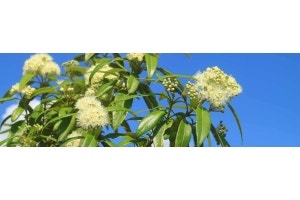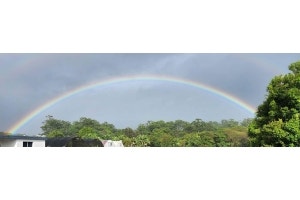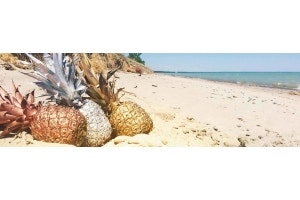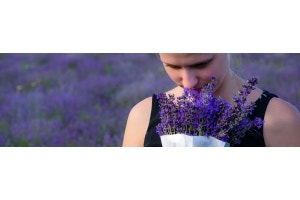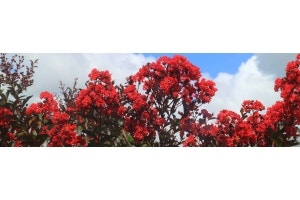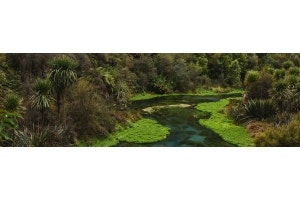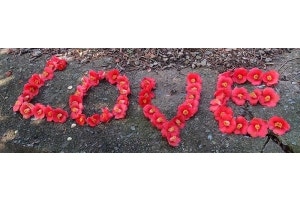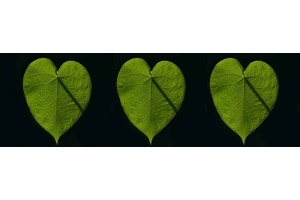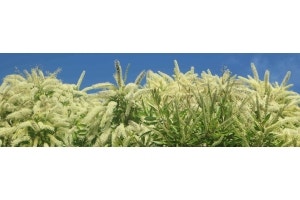
Most of us plan our gardens to look nice - colourful, lush and leafy, or at least, green and tidy. What if we planned our gardens to appeal to all of our senses? To look appealing, to smell sweet or herby, to sound gentle and relaxing, to feel soft, to taste delicious? What pleasures our gardens would bring!
Sensory Gardens - Smell
In times of stress, the calming scents of plants can be just what the doctor scribbled illegibly on their prescription pad. Whether it's rubbing the rough leaf of a lemon gum and inhaling that fresh, zesty tang; catching the rich sweet thread of white jasmine floating on the warm breeze; or brushing up against an overgrown patch of herbs and being instantly time-travelled to memories of a Mediterranean holiday - there's nothing quite like the extra dimension of fragrance to give you pleasure and emotion from your garden.

Sensory Gardens - Petrichor and Fougere
Even the earthy smell of damp soil after rain - that mossy, woodsy, mushroomy aroma - is, for some, finer than French perfume. Did you know? The word petrichor was invented and the phenomenon described by Australian CSIRO team Richard Thomas and Isabel Joy Bear, in their scientific paper "Nature of Argillaceous Odour" in 1964. So now when you smell that damp-soil fragrance, you have the word for it!
 The petrichor smell is closely associated to a whole fragrance family that parfumiers call fougere. That's the French word for fern, and fougere fragrances have a ferny, mossy, green and woody smell to them, like the understorey of a forest or a woodland clearing.
Did you know? In Japan there's a whole wellbeing movement called Shinrin-yoku, or forest bathing, where people go out into nature to breathe in the woodsy air to help them relax. Check out our post on Pteridomania Fern Fever for more ferny fabulousness, and create your own garden homage to fougere and forest fragrance!
The petrichor smell is closely associated to a whole fragrance family that parfumiers call fougere. That's the French word for fern, and fougere fragrances have a ferny, mossy, green and woody smell to them, like the understorey of a forest or a woodland clearing.
Did you know? In Japan there's a whole wellbeing movement called Shinrin-yoku, or forest bathing, where people go out into nature to breathe in the woodsy air to help them relax. Check out our post on Pteridomania Fern Fever for more ferny fabulousness, and create your own garden homage to fougere and forest fragrance!Sensory Gardens - Full-On Fragrance
 White scented plants are always in our best seller lists, year in year out.
White scented plants are always in our best seller lists, year in year out. You can discover a garden full of white scented plants in our post Which Plants Are Best For Scent. White flowers are often the most fragrant of all.
It's certainly true of these four best selling plants. One plant can perfume a whole garden : Clockwise from top left : mock orange ( Murraya ), gardenia (this one is the dwarf Grandiflora Star, with unusual non-double flowers), pink-bud jasmine (Jasminum ), and star jasmine (Trachelospermum )
Dusk Beauty
One advantage of white flowers is they are the last to be visible in the garden as twilight falls to night. Red and orange, blue and purple all disappear fast into dusk, while white blooms continue to shine out in the darkness, so you can enjoy your garden for longer each day.
 Less well-known than mock orange, gardenia and jasmine, but just as attractively scented, are these two white-flowered beauties.
They need it warm year-round, with regular water - so they're ideal for perfuming a lounge room or bedroom, as well as adding fragrance to an outdoor space.
Less well-known than mock orange, gardenia and jasmine, but just as attractively scented, are these two white-flowered beauties.
They need it warm year-round, with regular water - so they're ideal for perfuming a lounge room or bedroom, as well as adding fragrance to an outdoor space.
Amazon lily (Eucharis )looks like a super-glamorous daffodil, and produces fragrant flowers intermittently through the year; twining vine bridal wreath (Stephanotis) has dark leaves that provide the perfect backdrop to the pure white flowers.

Sensory Gardens - Tutti Frutti
Fruity smells are amongst the most popular - whether it's bananas and coconuts, berries and cherries, or lemon and lime. For a more unusual white-flower fragrance, plant a hedge of port wine magnolia (Michelia,left). This evergreen is also called coconut magnolia and banana magnolia - so you get an idea of the complexity and strength of its fragrance. To some noses it also smells like bubblegum! This is down to the isoamyl alcohol in the flowers - it's the same chemical compound that's found in bananas and black truffles!If you like a fruity fragrance, tea olive (Osmanthus, right) smells like peach yogurt - deliciously enticing on a warm breeze. The flowers aren't as showy as other white shrubs - but they are abundant and highly perfumed. They're small and nestle in the crooks of the branches; which means if you clip your hedges often, you won't lose the flowers like you would with showier shrubs.
Did you know? Port wine magnolia has a relative in their family which is one of the world's prized fragrances, and one which Buddhists believe helps you attain enlightenment. Oil from the champaca tree has been used for centuries to perfume hair - it's where we get the word 'shampoo' from.
Juicy Fruits
 Clockwise from top left :
Clockwise from top left :
Baby sage foliage (Salvia microphylla) smells of blackcurrants, as does the flowering currant, (Ribes). Tasty!
native daphne (Phaleria) is a rare native rainforest tree and one we don't often have in stock, but it's well worth waiting for. Those pretty white flowers, that emerge straight out of the branches, carry the fragrance of pineapple on the breeze. There's one or two planted along the Brisbane CBD riverbanks, so if you're in the city, have a sniff and follow your nose.... Golden-flowered Mexican marigold (Tagetes), bottom right, creates its own fruity cocktail, mixing blackcurrant with mint - it shouldn't work but it does, deliciously!
Many members of the Salvia family have a pleasant smell - as well as blackcurrant baby sage, and the classic culinary sage for stuffing, there's sand sage (Salvia lanceolata) which smells and tastes of lemon, and Tequila sage (Salvia gesneriiflora ) is said to smell of grapefruit.
Lemon-Lime Lovelies
True orange blossom, lemon, lime and kumquat flowers smell heady and rich, like the mock orange and star jasmine at the top of this post - it's the peel of the fruits that smells tangy and sharp. If you're looking for that zesty tang in your garden, there's lots of ways to achieve it. Many garden plants have a citrus scent.Top Tip : Look for the words 'citriodora/citriodorus' in the plant's botanic name, for an odour-of-citrus.
 Add some lemon-lime-loveliness to your day with this selection of the best in citrus-scented plants :
Add some lemon-lime-loveliness to your day with this selection of the best in citrus-scented plants : Clockwise from top left:
Bushtucker favourite lemon myrtle (Backhousia citriodora) smells good, and is used for adding lemon flavour or fragrance to foods and cleaning items too. Our product page has heaps of great ideas from cupcakes to soaps, all from our Facebook gardeners. Mozzie Blocker (Leptospermum liversidgei) will help keep those pesky midges away as well as smelling fresh; lemon cypress is super-lemony scented, and vibrantly citrus-coloured; and lemonwood (Pittosporum eugenioides) is intriguingly pine-citrus fragranced. If you like a more traditional resiny-pine scent, check out our conifers category where you'll find juniper, cypress, and pine.
Sensory Gardens - Gourmand Scent
Gourmand fragrances have been one of the most popular fragrance families in recent years.It seems everyone loves the comforting smell of foods! If you love these kind of fragrances, you'll love a garden full of the plants here. They'll add an extra dimension to your garden borders...
 Clockwise from top left : the paisley-patterned flowers of clove pink (Dianthus) have a peppery clove scent, and the flowers were traditionally used as flavourings for food and drink in Medieval times.
For an intense aromatic fragrance that may not be to everyone's taste - but is certainly unmistakable, and fun in a sensory garden - grey-leaved curry bush (Helichrysum) definitely lives up to its name.
Clockwise from top left : the paisley-patterned flowers of clove pink (Dianthus) have a peppery clove scent, and the flowers were traditionally used as flavourings for food and drink in Medieval times.
For an intense aromatic fragrance that may not be to everyone's taste - but is certainly unmistakable, and fun in a sensory garden - grey-leaved curry bush (Helichrysum) definitely lives up to its name. It's not for flavouring curries, it's grown for the bright silver foliage - which smells strongly of cumin and spices when the leaves warm up in sunshine.
Native nyrtle (Backhousia) trees are beloved for their fragrance (and flavouring!) Here we have aniseed myrtle (Backhousia anisata) which smells of licorice when crushed.
Its sibling grey myrtle (Backhousia myrtifolia) is also known as cinnamon myrtle, for the scent of its leaves.
The gourmand GOAT of gourmand flower fragrances has to be chocolate cosmos. The clue is in the name - it really smells like chocolate!
Pleasingly, the flower is a rich dark chocolate colour too. We rarely carry this and it sells out fast; if you're super-lucky you might get a sniff of this seductive scent.

Honey Honey
It makes sense that honeybees would love the smell of honey, but it turns out that other kinds of bees do too, and butterflies, and nectar-eating birds, and some tiny native mammals! To them, the honey scent promises them a sweet, nutritious, energy-packed treat. No wonder these flowers are such powerhouses at attracting all kinds of pollinators and wildlife. To us gardeners, it's a warm friendly scent that threads subtly through the air and deliciously intensifies on warm days.For a garden reminiscent of hot buttered toast, plant some of these. Clockwise from top left :
Yesterday today tomorrow (Brunfelsia) flowering for most of the warm months in ombre-shaded purple-lilac-white flowers; strawberries-and-custard coloured honeysuckle (Lonicera x heckrottii); butterfly bush (Buddleia), blooming from tubestock size; and sweet alyssum (Lobularia) for windowboxes and hanging baskets, rockeries and pots.
Sensory Gardens - Herbal Healing

There's plenty of olfactory pleasures to be had in a garden. Herbs are the obvious choice, giving you heaps of effortless aromatic scent, especially when you brush against the plants, or when the hot sun releases the essential oils into the air.If you've ever been lucky enough to visit the Mediterranean, you'll be familiar with this smell from oregano, basil, and thyme carpeting the hillsides. You can get more ideas on what to plant in our post Plant The Look - Grecian Style. Plant a row of sweet-smelling herbs at the edges of a path, or beside the driveway to your front door, so you (and your pets!) get a relaxing welcoming whiff when you return home. Having herbs close to the house makes it easy to pick and use them for cooking, in herbal tisanes and teas, and for folk remedies. Top Tip : Many plants keep their fragrance even after drying. So dry a few leaves or flower petals for a home-made pot pourri for your lounge room, or sew them into a little cotton bag for a wardrobe freshener.
Clockwise from top left : lavender (Lavandula), rosemary (Rosmarinus), chamomile (Chamaemelum ), and thyme.
Sensory Gardens - Smells To Take You Home
 The smell of the bush is a powerful emotional trigger for many Aussies - it's the smell of home. It's a complex blend of scents, as the warm sun releases the plants' essential oils.
Much of it is the smell of eucalypts and their relatives - but all gums smell differently to one another, mallee and tingle, marri and jarrah, karri and bloodwood. There's around twenty gum species that are used to produce those pungent herbal essential eucalyptus oils; they're fantastic for alleviating congestion and colds thanks to a substance called piperitone.
Blue gums are the classic 'eucalypt' scent for many.
The smell of the bush is a powerful emotional trigger for many Aussies - it's the smell of home. It's a complex blend of scents, as the warm sun releases the plants' essential oils.
Much of it is the smell of eucalypts and their relatives - but all gums smell differently to one another, mallee and tingle, marri and jarrah, karri and bloodwood. There's around twenty gum species that are used to produce those pungent herbal essential eucalyptus oils; they're fantastic for alleviating congestion and colds thanks to a substance called piperitone.
Blue gums are the classic 'eucalypt' scent for many. But wait! There's also strawberry gum, (Eucalyptus olida);peppermint gum, (Eucalyptus elata); (Eucalyptus olida); honey box, (Eucalyptus melliodora); and lemon gum ( Corymbia citriodora) amongst many more.We can't resist a little scratch-and-sniff every time we pass the native lemon gum nursery plants. The leaves feel pleasantly rough to touch, and super-freshly zesty to smell.
 We source and grow smaller varieties of gums, better-sized for the average suburban garden, but some native gums will grow larger, and are better suited to acreage. Site larger gum trees appropriately, or keep them regularly coppiced - that's cut hard back - all the better to reach those leaves for an invigorating sniff!
We source and grow smaller varieties of gums, better-sized for the average suburban garden, but some native gums will grow larger, and are better suited to acreage. Site larger gum trees appropriately, or keep them regularly coppiced - that's cut hard back - all the better to reach those leaves for an invigorating sniff!
Easier to find a home for in most gardens, these smaller shrubby natives will add a deeper layer of fragrance to your back-yard bushland. They have very pretty flowers, but it's the leaves that carry the fragrance. Clockwise from top left:
mint-herbal native mint bush (Prostanthera ),
apple-scented eriostemon (Philotheca),
minty dwarf peppermint willow (Agonis),
and lemony-fresh Geraldton wax (Chamelaucium).
Sensory Gardens - Hidden Secrets
 Some fragrant flowers are not as showy as mock orange and gardenia, honeysuckle and buddleia - but what they lack in size they definitely make up for in perfume power. On a warm still day you'll catch the sweet scent of these long before you track down where it's coming from. It will be your garden's best kept secret...
One of the very best of these stealth perfumers is sweet box (Sarcococca), left- its tiny white flowers nestle amongst the deep green leaves, almost hidden, and yet they can perfume an entire garden. We think they smell like the most expensive moisturiser!Another undercover fragrance is our native brown boronia, right - the variety we carry, Dark Prince, has larger flowers than the species form and heaps of them, so it's ornamental as well as sweet-scented.
Some fragrant flowers are not as showy as mock orange and gardenia, honeysuckle and buddleia - but what they lack in size they definitely make up for in perfume power. On a warm still day you'll catch the sweet scent of these long before you track down where it's coming from. It will be your garden's best kept secret...
One of the very best of these stealth perfumers is sweet box (Sarcococca), left- its tiny white flowers nestle amongst the deep green leaves, almost hidden, and yet they can perfume an entire garden. We think they smell like the most expensive moisturiser!Another undercover fragrance is our native brown boronia, right - the variety we carry, Dark Prince, has larger flowers than the species form and heaps of them, so it's ornamental as well as sweet-scented. Aussie icon Kylie imitates native boronia in her Darling perfume - and you can have the real thing growing in your back yard.
If you don't have the space for a large shrub in your garden, you can still enjoy scent.
These two tiny plants give off an immense amount of perfume, and will grow in a pot or tucked into a shady nook.
 The tiny bells of lily of the valley (Convallaria), left, punch far above their weight; who would think something so tiny could smell so sweet and strong? You'll find this one in our Bulbs category in spring when it's planting time.
The tiny bells of lily of the valley (Convallaria), left, punch far above their weight; who would think something so tiny could smell so sweet and strong? You'll find this one in our Bulbs category in spring when it's planting time. Smallest of all when it comes to height, but not when it comes to scent : sweet violet (Viola odorata), right, also called parma violet. It's been one of the most beloved fragrant flowers for centuries. The origin of the violet's smell is down to the chemical ionone, which is also present in peach-scented osmanthus, and tea roses, showing how versatile it is.Petite enough to pop in a pocket, viola flowers are edible too - so you can feast on fragrance wherever you go.
Twentieth century writer DH Lawrence was a big violet fan :
If you catch a whiff of violets from the darkness of the shadow of manWhether your perfume preference is fruity or fougere, fancy gourmand or straightforward floral, exotically tropical or the smell of the bush; we hope this has given you plenty of ideas for making your garden - and your life - smell that little bit sweeter, for just a few bucks.
it will be spring in the world,
it will be spring in the world of the living;
wonderment organising itself, heralding itself with the violets,
stirring of new seasons.
























